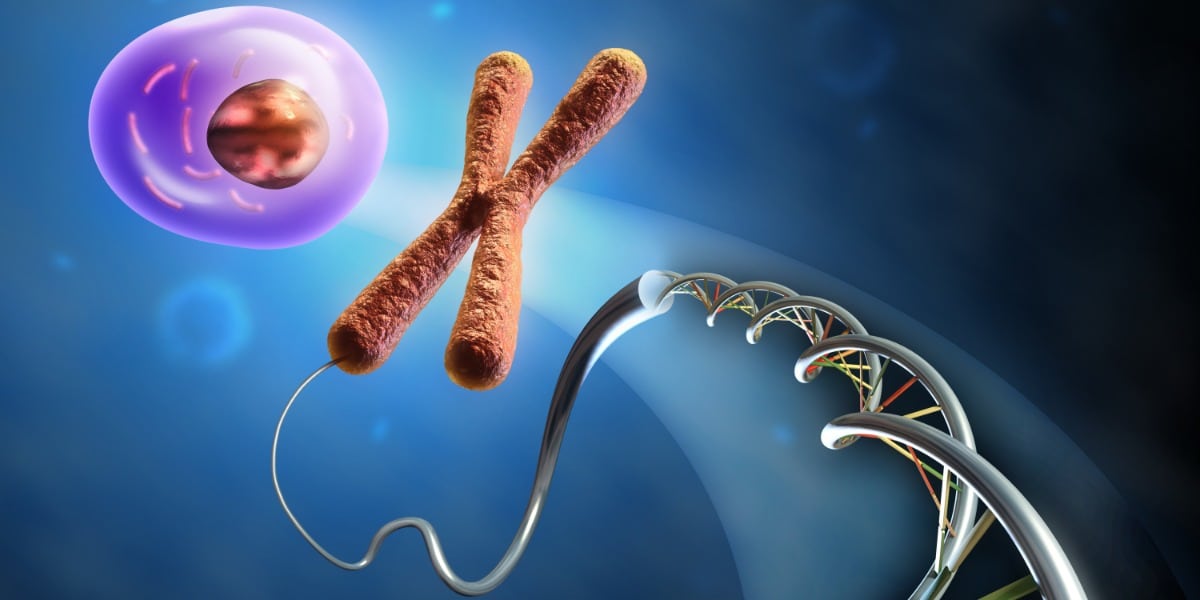Chromosome Analysis by Flow Cytometry

In most people’s minds a flow cytometer can sort, view and count cells e.g. lymphocytes, thymocytes, cultured cells and even non-mammalian cells such as yeast or bacteria. However, in reality, a flow cytometer is capable of providing information about any particle as long as it has detectable fluorescence. This fluorescence may occur either inherently or via an engineered label or antibody. In this way, we can look at much more (or less!) than whole cells e.g. isolated mitochondria, Golgi or whole chromosomes.
Yes, you read right, even chromosomes! In fact, flow cytometry was pivotal to the success (and speed) of the Human Genome Project. Without the ability to isolate pure chromosome populations, we might still be waiting for the release of the human genome sequence!
As Usual, Sample Preparation Is Key!
So how do we go about looking at chromosomes on a flow cytometer? It is actually quite simple in theory but, as with so many techniques, it can actually be quite tricky in practice. The following pointers will help you on your way:
Firstly, to isolate chromosomes, cells should be in metaphase (i.e. where the chromosomes separate in preparation for cell division).
We can achieve this by:
1. Treating cells with drugs that arrest or trap cells in metaphase. Colcemid, sometimes known as demecolcine, is a common choice.
2. Once cells accumulate in metaphase, proceed by lysing the cells with a detergent, thus releasing the chromosomes. Easy peasy!
3. The isolated chromosomes are then ready for staining dyes that allow us to separate the different chromosome types (e.g. X, Y, chromosome 13).
Staining Chromosomes
How do we do this? Well, we can use two DNA binding dyes that have different base-pair specificities. The gold standard method calls for either of two stains:
- Chromomycin A3 (which is interesting also an antibiotic!), which binds to GC-rich regions of DNA.
- A Hoechst stain (e.g. 33258 or 33342), that binds to AT-rich regions.
Using these DNA stains, we can separate the larger chromosomes from the smaller ones as they will contain more DNA and will thus yield a greater fluorescence signal. As the base pair ratio of the chromosomes (in any species) varies, the stained DNA will appear in unique places in a dot plot depending on their base pair composition as well as their size. Using this simple strategy, it is possible to clearly separate most human chromosomes (see Figure 1). This approach is not suitable for human chromosomes 9-12 and 14-15 however, because these chromsomes are too similar in size and base pair composition for high-resolution separation.
Chromosome analysis is also possible for other species, as long as the chromosomes differ sufficiently in size and nucleotide sequence. One area where this is difficult is in karyotyping plant species, and the bivariate (two dyes) approach described above usually doesn’t yield significantly better results than using a single DNA binding dye, which is often DAPI or propidium iodide.

Figure 1: Human chromosomes stained with two different DNA binding dyes and run on a FACS440 cell sorter. The presence of an X chromosome only shows this is a female karyotype. For a further explanation, check out this article.
If It Sounds Too Good to Be True…
As with most techniques, there are a few pitfalls to watch out for:
- The preparation of a good chromosome sample depends greatly on several factors:
- Timing of the block/arrest method, and the agent used
- Composition of the stabilizing buffer
- Duration of staining
- Preparation of the cytometer. This part can be cumbersome, which is probably why chromosome analysis by flow cytometry is not widespread.
- The DNA binding dyes mentioned above are not very common and neither are the wavelength combinations needed to excite them. Although Hoechst is excited by a fairly common wavelength (355nm), Chromomycin A3 is excited optimally at 457nm, which is rather uncommon. Therefore, analysis and more importantly sorting of chromosomes tends to be done on specifically set up machines, making it harder to implement this technique for the first time.
- In addition, and because the differences in DNA content between chromosomes are small, great care has to be taken with the alignment of the cytometer. This can prove costly, often demanding a dedicated sorter (and an operator!).
Chromosome sorting is an exciting technique as long as you are aware of the pitfalls and you have the time to get it right!
As well as the widely acclaimed Human Genome Project where isolated chromosomes were used to perform DNA sequencing, chromosome sorting is useful in generating specific DNA libraries and for making ‘chromosome paints’ which are useful in the diagnosis of chromosomal disorders. For more detailed information on chromosome sorting, you can check out this popular review article.
Have you use flow cytometry to sort and analyze chromosomes? Share your experiences with us by writing in the comments section!
Further Reading
- Davies DC, Monard SP, Young BD. Chromosome analysis and sorting by flow cytometry. In “Flow Cytometry: A Practical Approach”, 3rd Edition, Ed. MG Ormerod. OUP, Oxford, 2000.
- Doležel J, Kubaláková M, Cíhalíková J, Suchánková P, Simková H. (2011).
Chromosome analysis and sorting using flow cytometry. Methods701:221-38. - Gray JW, Langlois RG, Carrano AV, Burkhart-Schulte K, Van Dilla MA. (1979).
High resolution chromosome analysis: one and two parameter flow cytometry. Chromosoma. 73, 9–27 - Carter NP. (1994). Cytogenetic analysis by chromosome painting.
Cytometry.18(1):2-10